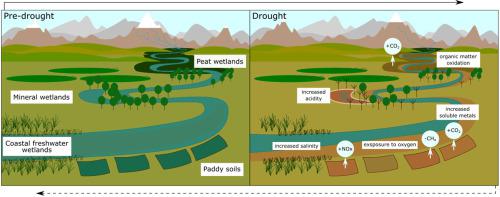当前位置:
X-MOL 学术
›
Earth Sci. Rev.
›
论文详情
Our official English website, www.x-mol.net, welcomes your
feedback! (Note: you will need to create a separate account there.)
Drought effects on wet soils in inland wetlands and peatlands
Earth-Science Reviews ( IF 10.8 ) Pub Date : 2020-11-01 , DOI: 10.1016/j.earscirev.2020.103387 E. Stirling , R.W. Fitzpatrick , L.M. Mosley
Earth-Science Reviews ( IF 10.8 ) Pub Date : 2020-11-01 , DOI: 10.1016/j.earscirev.2020.103387 E. Stirling , R.W. Fitzpatrick , L.M. Mosley

|
Abstract Soils associated with wet and ephemerally wet environments, i.e. wet soils, cover an area greater than 12.1 million km2; inland wetlands deliver at least Int$27.0 trillion in tangible and intangible benefits. However, due to their intimate association with wet environments, wet soils are at risk of degradation during drought events. This review investigates the effects of drought on wet soils, with particular attention to the changes in soil geochemistry and greenhouse gas emissions. It is clear from this review that drought poses a significant threat to wet soils, a threat which can be difficult to determine before an event but which poses a catastrophic risk to some sites. Drought causes oxygen penetration to increase in wet soils, leading to an increase in oxidation of organic matter and reduced inorganic species (e.g. sulfides). Oxidation of these materials can lead to soil acidification, metal mobilization and to negative impacts on water quality. Increased oxygen in the soil profile also affects biogeochemical cycling, with increased production of nitrous oxide and decreased production of methane. Effects of drought differ between peat and mineral soil types and subtypes. Wet soils undergo major chronological transformations and biogeochemical changes in the alteration of environments occurring before, during and after drought conditions. Water conditions (i.e. subaqueous, saturated, unsaturated and resaturated) also play a major role in chronological soil transformations. Soils may not easily recover between severe droughts and instead enter alternative stable states. This review highlights substantial gaps in our understanding of the effects of drought on wet soils and shows that previous studies overrepresent relatively small geographical regions.
中文翻译:

干旱对内陆湿地和泥炭地湿土壤的影响
摘要 与潮湿和短暂潮湿环境相关的土壤,即潮湿土壤,覆盖面积超过 1210 万平方公里;内陆湿地提供至少 27.0 万亿美元的有形和无形效益。然而,由于它们与潮湿环境的密切联系,潮湿的土壤在干旱事件中面临退化的风险。本综述研究了干旱对潮湿土壤的影响,特别关注土壤地球化学和温室气体排放的变化。从这次审查中可以清楚地看出,干旱对潮湿土壤构成了重大威胁,这种威胁在事件发生之前很难确定,但对某些地点构成了灾难性风险。干旱导致湿土壤中的氧气渗透增加,导致有机物质氧化增加和无机物种(例如硫化物)减少。这些材料的氧化会导致土壤酸化、金属迁移并对水质产生负面影响。土壤剖面中氧气的增加也会影响生物地球化学循环,一氧化二氮的产量增加,甲烷的产量减少。干旱对泥炭和矿质土壤类型和亚型的影响不同。在干旱条件发生之前、期间和之后发生的环境改变中,湿土壤经历了重大的时间顺序转变和生物地球化学变化。水条件(即水下、饱和、不饱和和再饱和)也在时间顺序的土壤转变中起主要作用。土壤在严重干旱之间可能不容易恢复,而是进入替代的稳定状态。
更新日期:2020-11-01
中文翻译:

干旱对内陆湿地和泥炭地湿土壤的影响
摘要 与潮湿和短暂潮湿环境相关的土壤,即潮湿土壤,覆盖面积超过 1210 万平方公里;内陆湿地提供至少 27.0 万亿美元的有形和无形效益。然而,由于它们与潮湿环境的密切联系,潮湿的土壤在干旱事件中面临退化的风险。本综述研究了干旱对潮湿土壤的影响,特别关注土壤地球化学和温室气体排放的变化。从这次审查中可以清楚地看出,干旱对潮湿土壤构成了重大威胁,这种威胁在事件发生之前很难确定,但对某些地点构成了灾难性风险。干旱导致湿土壤中的氧气渗透增加,导致有机物质氧化增加和无机物种(例如硫化物)减少。这些材料的氧化会导致土壤酸化、金属迁移并对水质产生负面影响。土壤剖面中氧气的增加也会影响生物地球化学循环,一氧化二氮的产量增加,甲烷的产量减少。干旱对泥炭和矿质土壤类型和亚型的影响不同。在干旱条件发生之前、期间和之后发生的环境改变中,湿土壤经历了重大的时间顺序转变和生物地球化学变化。水条件(即水下、饱和、不饱和和再饱和)也在时间顺序的土壤转变中起主要作用。土壤在严重干旱之间可能不容易恢复,而是进入替代的稳定状态。











































 京公网安备 11010802027423号
京公网安备 11010802027423号